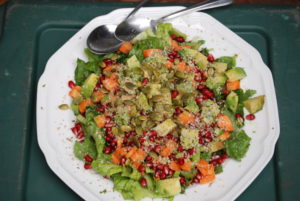I have a new ugly sunhat and it gets just as many funny looks as the last ugly sunhat – sometimes there is no winning solution if you are unhealthy except to do what you have to do to stay healthy. I thought the new hat was slightly less odd as it’s a straw hat, summery, but oh well. I need a broad brim for sun protection. Cute hats don’t always have a brim or a large floppy beach hat has too much brim and can obstruct your ability to see.
Due to a tendency to develop severe rashes or eczema I need natural fibers. Modern fabrics can leave me itching and as my autoimmune disease has worsened I’ve even had problems with rashes that lead to a lack of skin – an open sore over a large patch is painful more than itchy. Fashion may be fun but not as much fun as having skin. Sewing my own clothes allows my own fabric choices. Hunting through resale shops for natural fiber clothing can be another way to find items that don’t make me sick. Organically grown cotton products are available in limited styles and limited places for a price that is generally more than a department store price but probably less than an expensive fashionable brand.
Laundry detergents or fabric softeners can also leave me with an allergic reaction. Having overactive white blood cells means the allergic and autoimmune sensitivities are more likely to occur – there is one bonus, cancer cells may be more likely to be identified and removed. Until it is a severe condition someone with autoimmune disease may be less likely to have cancer due to the overactive white blood cells. Increased inflammation in a patient and those with “dermatomyositis,” type of infllammatory autoimmune disease were more associated with cancer risk than some other types of arthritis like autoimmune diseases, “systemic autoimmune rheumatic diseases (SARDs), in a large study.” [3] Someone with autoimmune disease can be at greater risk of developing another type of autoimmune disease however. [1]
Adequate treatment of hypothyroidism might have an additional benefit of reducing risk of demyelination and development of Multiple sclerosis. [1]
“For example, an intriguing finding based on a rodent model of chronic demyelination indicates that administration of thyroid hormone can enhance remyelination under certain conditions (31, 32). Relevance of this finding to multiple sclerosis in humans is unknown, but, hypothetically, routine treatment of hypothyroidism could diminish the risk of multiple sclerosis.” [1]
The sunhat is helping reduce inflammatory reactions that can make underlying autoimmune symptoms worse. Oxidative stress is another way to say inflammatory reactions and a variety of things in addition to excessive sun exposure can lead to oxidative stress and increased production of free radicals – a type of reactive chemical which antioxidant foods helps to detoxify safely rather than allowing an increase in negative health symptoms. Pollution and smoking can also be external factors in addition to excess sun exposure which can be a cause of inflammatory oxidative stress. [2]
Eating adequate but not necessarily excessive amounts of antioxidant rich foods can help the body detoxify the free radical chemicals safely. Excessive supplements or very rich food sources of antioxidants can tip the chemical balance too far in the other direction. Studies with supplements of vitamin E and vitamin A found that some is good but more isn’t. Sesame seeds are a good source of a variety of nutrients and have been tested for helping with the oxidative stress caused by athletic exercise, two tablespoons per day were found to be a helpful and safe amount. See: Effects of Sesame (Sesamum indicum L.) Supplementation on Creatine Kinase, Lactate Dehydrogenase, Oxidative Stress Markers, and Aerobic Capacity in Semi-Professional Soccer Players. [4(G3.8)]
More information antioxidant rich foods and on oxidative stress and who is more at risk of having inflammatory oxidative stress reactions is available in this post on my other blog site: https://effectiveselfcare.info/2017/09/08/three-negative-stress-can-trigger-the-fight-flight-response-whos-at-risk/
- Disclaimer: Opinions are my own and the information is provided for educational purposes within the guidelines of fair use. While I am a Registered Dietitian this information is not intended to provide individual health guidance. Please see a health professional for individual health care purposes.
-
Are Individuals With an Autoimmune Disease at Higher Risk of a Second Autoimmune Disorder?, American Journal of Epidemiology, Volume 169, Issue 6, 15 March 2009, Pages 749–755, https://academic.oup.com/aje/article/169/6/749/90353
- Anu Rahal, Amit Kumar, Vivek Singh, Brijesh Yadav, Ruchi Tiwari, Sandip Chakraborty, and Kuldeep Dhama, Oxidative Stress, Prooxidants, and Antioxidants: The Interplay, Biomed Res Int. 2014; 2014: 761264. https://www.ncbi.nlm.nih.gov/pmc/articles/PMC3920909/
-
Kuang-Hui Yu, MD, Chang-Fu Kuo, MD, PhD, Lu Hsiang Huang, MSc, Wen-Kuan Huang, MD, and Lai-Chu See, PhD, Cancer Risk in Patients With Inflammatory Systemic Autoimmune Rheumatic Diseases, Medicine (Baltimore). 2016 May; 95(18): e3540. https://www.ncbi.nlm.nih.gov/pmc/articles/PMC4863778/
- 8. Barbosa CV, Silva AS, de Oliveira CV, et al., Effects of Sesame (Sesamum indicum L.) Supplementation on Creatine Kinase, Lactate Dehydrogenase, Oxidative Stress Markers, and Aerobic Capacity in Semi-Professional Soccer Players. Front Physiol. 2017 Mar 31;8:196.https://www.ncbi.nlm.nih.gov/pubmed/28408889 (G.8)

